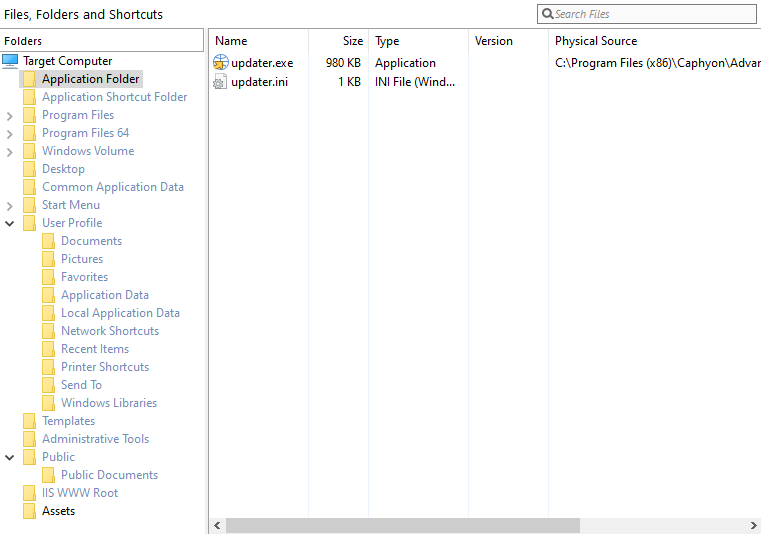
Guide to File System Navigation During Software Deployment

Guide to File System Navigation During Software Deployment
Table of Contents
- Introduction
- Registration
- Using Advanced Installer
- GUI
- Working with Projects
- Installer Project
* Product Information
* Resources
* Files and Folders
* Files
* Temporary Files
* File Operations
* Folders
* Permissions Tab - Installer Project
* Shortcuts
* Shortcuts
* INI Files
* XML Files
* JSON Files
* Text File Updates
* Windows Libraries
* Tiles
* Java Products
* Registry
* File Associations
* Assemblies
* Drivers
* Services
* Package Definition
* Requirements
* User Interface
* System Changes
* Server
* Custom Behavior - Patch Project
- Merge Module Project
- Updates Configuration Project
- Windows Store App Project
- Modification Package Project
- Optional Package Project
- Windows Mobile CAB Projects
- Visual Studio Extension Project
- Software Installer Wizards - Advanced Installer
- Visual Studio integration
- Alternative to AdminStudio/Wise
- Replace Wise
- Migrating from Visual Studio Installer
- Keyboard Shortcuts
- Shell Integration
- Command Line
- Advanced Installer PowerShell Automation Interfaces
- Features and Functionality
- Tutorials
- Samples
- How-tos
- FAQs
- Windows Installer
- Deployment Technologies
- IT Pro
- MSIX
- Video Tutorials
- Advanced Installer Blog
- Table of Contents
Disclaimer: This post includes affiliate links
If you click on a link and make a purchase, I may receive a commission at no extra cost to you.
Files and Folders Page - Installer Project
You can specify most of the install operations concerning files, folder or shortcuts in the Files and Folders page.

- Files
Adding and removing files to the installation; setting file properties; specifying file removal operations; registering fonts; hashing files. - Temporary Files
Adding and removing temporary files to the installation; setting temporary file properties. - File Operations
Creating and removing file operations; editing their properties. - Folders
Adding and removing folders to the installation; setting folder properties; specifying folder removal operations; synchronizing folders. - Shortcuts
Adding and removing shortcuts in the installation; setting shortcut properties. - INI Files
Adding and removing INI files and entries to the installation. - XML Files
Create or update XML files. - Text File Updates
Create TXT Update files. - Windows Libraries
Create or update Libraries.
The files, folders or shortcuts will be placed in one of theFolders presented in the left pane of the view.
In addition to the regular Windows Installer folders, there are two special application folders defined: one for the application files (“Application Folder”) and one for the application shortcuts (“Application Shortcut Folder”). The paths of these two folders can be overridden by the user at run-time, therefore they allow the user to change the location where the application is installed. By default they resolve to the paths defined in the Install Parameters page.
The right pane lists all the files from the selected folder of the left panel, and their details. If a file doesn’t exist anymore at the specified location, it will be shown with a question mark icon  and “???” as its size. You can restore this file by double-clicking it and setting its correct path.
and “???” as its size. You can restore this file by double-clicking it and setting its correct path.
Setting the Current Feature
Advanced Installer will create components for the added resources as necessary, placing them under the Current Feature. In order to change the current feature you can use the drop-down list box in the toolbar.
You can further manage your package’s organization in the Organization page. Note that the components created in this page respect the Windows Installer rules and best practices.
This feature is not available for Merge Module projects. For more details see the Merge Module Organization page.
Visible Members
The feature is available starting with the Advanced Installer Professional Edition.
This option enables you to filter the members that are displayed on the Files And Folders page by their type. For example, you can only display Files, Shortcuts, INI Files, Xml Files, Json Files, File Removal operations, File Duplication operations, File Move operations, Temporary Files, Libraries, Text File Updates, File Downloads, Extract Archives or any combination of the above elements. To achieve this, click on the_Visible Members_ toolbar button and select from the menu what types of members you want to display.
Topics
- Files
Working with files in the Files and Folders page in the Installer Project. - Temporary Files
Working with temporary files and folders. - File Operations
Copy, move, remove files. - Folders
Working with folders in the Files and Folders page in the Installer Project. - Permissions Tab - Installer Project
How to set permission for Advanced Installer objects: files, folders, registry keys and value. - Shortcuts
Working with shortcuts in the Files and Folders page. - Shortcuts
Working with shortcuts in the Files and Folders page. - INI Files
Working with INI files in the Files and Folders page. - XML Files
Create and edit XML files. - JSON Files
Create and edit JSON files. - Text File Updates
Create Text File Updates - Windows Libraries
Create and update Windows Libraries.
Did you find this page useful?
Please give it a rating:
Thanks!
Report a problem on this page
Information is incorrect or missing
Information is unclear or confusing
Something else
Can you tell us what’s wrong?
Send message
Also read:
- [New] Complete Action Camera Buying Guide For Beginners
- [New] In 2024, Can You Broadcast Videos Without Infringing Laws, Specifically FB?
- 10+ Best Instagram Video Editor for PC, Online, Android for 2024
- 2024 Approved Affordable Android Calls, 10 Best Selection
- 2024 Approved Innovative Watermarks for Impactful Insta Imagery
- Comprehensive Tutorial on How to Descend From iTunes 12.1 to Older Software Editions
- Effortless Guide: Mastering Edit Options in XML Configuration Interface
- How To Identify & Revoke Admin Rights of Unseen Devices on Android: A Guide by MalwareFox
- How to Reset a Infinix GT 10 Pro Phone that is Locked?
- How To Silence the Verbal Directions Feature On A Samsung Set-Top Box
- In 2024, Android Unlock Code Sim Unlock Your Samsung Galaxy A15 5G Phone and Remove Locked Screen
- Maximizing Digital Footprint: Effective Techniques for Increasing Webpage Sizes and Additional Content Options
- Ultimate Guide to Top-Ranking Automated Background Eliminators: Why Everyone Needs One
- Title: Guide to File System Navigation During Software Deployment
- Author: Joseph
- Created at : 2024-10-08 22:13:48
- Updated at : 2024-10-11 06:34:51
- Link: https://fox-tls.techidaily.com/guide-to-file-system-navigation-during-software-deployment/
- License: This work is licensed under CC BY-NC-SA 4.0.